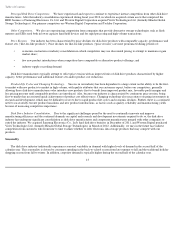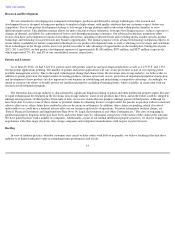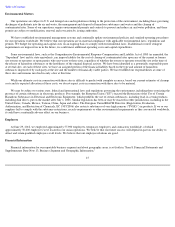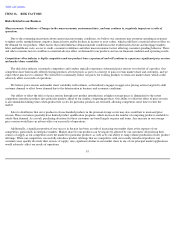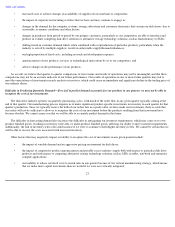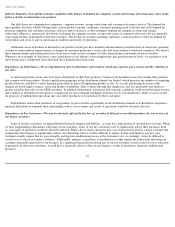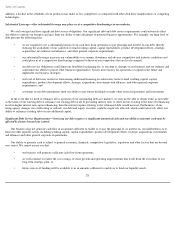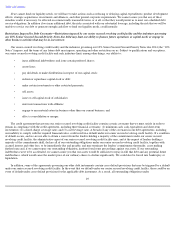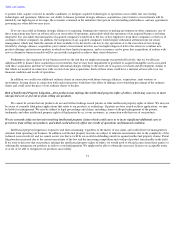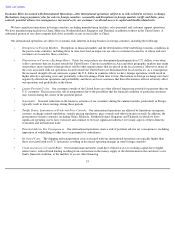Seagate 2011 Annual Report Download - page 26
Download and view the complete annual report
Please find page 26 of the 2011 Seagate annual report below. You can navigate through the pages in the report by either clicking on the pages listed below, or by using the keyword search tool below to find specific information within the annual report.
Table of Contents
Smaller Form Factor Products
—If we do not continue to successfully market smaller form factor products, our business may suffer.
The disk drive industry is experiencing significant increases in sales of smaller form factor disk drives or other electronic data storage
technologies for an expanding number of applications, in particular notebook computers and consumer electronic devices, but also in personal
computers and enterprise storage applications. Our future success will depend on our ability to develop and introduce smaller form factor
products at desired price and capacity points faster than our competitors.
We have experienced competition from other companies that produce alternative storage technologies like solid state or flash memory,
where increased capacity, improving cost, energy efficiency and performance ruggedness have resulted in flash memory largely replacing disk
drives in handheld applications. We believe that the demand for disk drives to store or back up related media content from such handheld
devices, however, continues to grow. While this competition has traditionally been limited to the markets for handheld consumer electronics
applications, these competitors have announced SSDs for tablet, notebook and enterprise compute applications.
If we do not suitably adapt our product offerings to successfully introduce additional smaller form factor disk drives or alternative storage
products based on flash storage technology, or if our competitors are successful in achieving customer acceptance of SSD products for tablet,
notebook and enterprise compute applications, then our customers may decrease the amounts of our products that they purchase, which would
adversely affect our results of operations.
Dependence on Supply of Components, Equipment and Raw Materials
—If we experience shortages or delays in the receipt of, or cost
increases in, critical components, equipment or raw materials necessary to manufacture our products, we may suffer lower operating
margins, production delays and other material adverse effects.
The cost, quality and supply of components, certain equipment and raw materials used to manufacture disk drives and key components like
recording media and heads are critical to our success. The equipment we use to manufacture our products and components is frequently custom
made and comes from a few suppliers and the lead times required to obtain manufacturing equipment can be significant. Particularly important
components for disk drives include read/write heads, aluminum or glass substrates for recording media, ASICs, spindle motors, printed circuit
boards, and suspension assemblies. We rely on sole suppliers or a limited number of suppliers for some of these components that we do not
manufacture, including aluminum and glass substrates, read/write heads, ASICs, spindle motors, printed circuit boards, and suspension
assemblies. Many of such component suppliers are geographically concentrated, in particular, in Thailand, which makes our supply chain more
vulnerable to regional disruptions such as the recent flooding in Thailand, which has had a material impact on the production and availability of
many components. If our vendors for these components are unable to meet our cost, quality, and supply requirements, we could experience a
shortage in supply or an increase in production costs, which would adversely affect our results of operations.
Certain rare earth elements are critical in the manufacture of our products. We purchase components that contain rare earth elements from a
number of countries, including the People's Republic of China. We cannot predict whether any nation will impose regulations, quotas or
embargoes upon the rare earth elements incorporated into our products that would restrict the worldwide supply of such metals or increase their
cost. We have experienced increased costs and production delays when we were unable to obtain the necessary equipment or sufficient quantities
of some components, and/or have been forced to pay higher prices or make volume purchase commitments or advance deposits for some
components, equipment or raw materials that were in short supply in the industry in general. If any major supplier were to restrict the supply
available to us or increase the cost of the rare earth elements used in our products, we could experience a shortage in supply or an increase in
production costs, which would adversely affect our results of operations.
23


